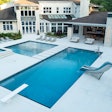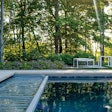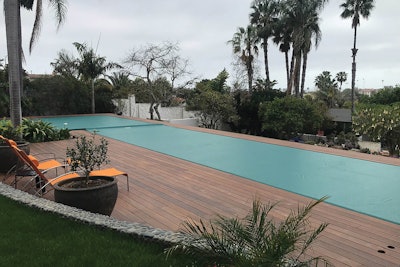
It's been a busy summer for APC installers across the land. It’s not easy to complete a packed schedule of installations, each one meeting myriad and often contradictory customer demands while still remaining functional, reliable and safe.
Those customer demands and installation hurdles vary not just from home to home, but from region to region: from the hectic density of New York to sunny and stylish San Diego, and everything in between. Below, two installers from the right and left edges of the United States share stories on how they do everything from hiding tracks, humping components up 24 flights of stairs and generally making the impossible possible.
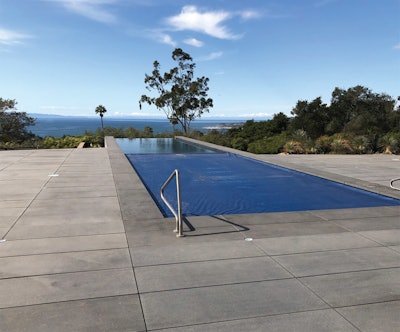 courtesy Poolsafe
courtesy Poolsafe
AUTOMATIC POOL COVERS IN THE CITY
Eric Kietsock, regional technical manager of Cover Care, has been installing automatic pool covers on pools in New York City, Long Island, New Jersey and Southern Connecticut for over 20 years. Because of the density of these cities, additional permits and certifications, and not to mention parking, Eric has had to develop specific systems to navigate tight hallways, elevators, parking structures and traffic to install covers on penthouse pools, mansions in the Hamptons and indoor commercial pools in basement high-rises.
“I work 16- to 18-hour days in our area. But that time isn’t all spent poolside,” Kietsock explains. “In fact, much of our time is spent planning and preparing…doing things like arriving at the jobsite prior to the installation in order to measure the size of an elevator, hallway or staircase. We always have to do a walk-through before bringing in our materials.”
Unlike automatic pool cover installers in other regions of the country that can just pull up to a backyard to install an auto cover, Kietsock and his team need to get a parking permit to even position their truck next to the building where the installation will take place so they can deliver the materials. “In most cases, we pull the truck up into a permitted parking space, unload all the materials, and get them to the jobsite (often on a rooftop penthouse). Then we have a second SUV vehicle, which gets parked in the building’s parking lot so we can get our crew home after the job is complete.”
Kietsock explains that materials often need to be craned in, which, of course, requires crane permits and more. “On one particular job, the only access we had was a staircase, and I had to walk all the materials and components up and down stairs for an entire day.”
There are also additional levels of security and compliance, especially in buildings in New York City. “We have a lot of unions in this area, so we need to get special maintenance permits that are sponsored by a union in order to access the pool and automatic pool cover,” explains Kietsock. “And of course, there are also the required building safety meetings, especially on new construction projects, as often the original plans in these buildings have changes made that affect, for example, how and from where we draw and access power.” All of this is in addition to higher level OSHA requirements and working with security guards for some of these very private residences where taking photos is never allowed.
Traffic is a bear for many throughout the country, and Kietsock’s region is no exception. “Because the traffic is horrendous in this tri-state area, we always load our trucks the night before, so we can get on the road by 5 a.m. Leaving a half hour later in the morning could mean an extra hour or more in traffic driving to the Hamptons, for example,” he says.
In terms of construction, these high-end, custom jobs require that Kietsock and his team always build their own concrete box/vaults to house the auto cover and mechanism. “We typically never use a polybox, which is common throughout most of the country,” explains Kietsock. “We pour and form our own boxes with our own footings working around challenges like clay in New Jersey, glass tiles in Connecticut and sandy soil throughout Long Island.”
Kietsock does some amazing custom automatic pool cover installations, but because of all the regulations and privacy concerns of these pool owners, he doesn’t get nearly as many photos of the finished jobs as he would like. “Between the long hours, the hassles around doing the installations, and the number of covers we need to get installed each season, we just don’t have time to take photos,” says Kietsock. “But we always get the referral, and because we are a part of the Cover Care network, we continue to service these auto covers. Maybe eventually I’ll make it a point to try to get more photos, as we really do some amazing work.”
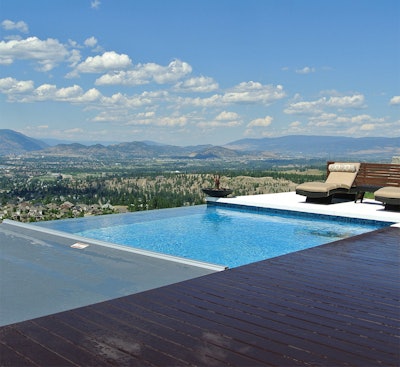 Allan Horwood
Allan Horwood
SAN DIEGO-STYLE AUTO COVERS
On the left coast of the country, John Moss, San Diego area manager of PoolSafe in San Marcos, says one of the biggest challenges of installing automatic pool covers in Southern California is saying ‘no’ to incredibly complex, custom projects. “In Southern California, pools are all about customization. There is never a standard pool,” explains Moss. “And Southern California builders are always looking to do a more amazing pool, which means the automatic pool cover needs to somehow function within these amazing designs.”
In the San Diego area, Moss explains that installing automatic pool covers on vanishing-edge pools is something they do all year round. “Vanishing-edge pools are commonplace for us, so we have become experts in the installation of auto covers on them,” says Moss. “And now, we are becoming experts on perimeter overflow pools, which are also becoming a common, custom installation.”
Doing vanishing-edge pools with automatic pool covers has become an everyday installation without issues, as long as the design is planned out ahead of time. “We know how important it is to hide the rack, because seeing the track of the automatic pool cover really kills the look of a vanishing-edge pool,” explains Moss. “But we can walk builders through the importance of angling the wall in or out of the pool and the offset beyond the vanishing edge to keep the pool cover system functional and completely hidden.”
According to Moss, the key is to plan the automatic pool cover design before the beginning of pool construction. “We work closely with builders to explain that a few small changes will ensure the installation goes smoothly and that the customer gets the most aesthetically pleasing finished cover installation,” says Moss. “It’s very important to be able to take into consideration everything from the coping to the slope of the walls.” Collaborative planning between the auto-cover installer and the builder is key to ensuring the successful installation of the pool cover — not only for aesthetics, but for functionality and to ultimately make the pool safe.
In Moss’ market, pool owners expect the cover to completely disappear when the automatic pool cover is open. “This custom feature has also become a standard for our area, because it’s become so commonplace,” he explains. “So not only will the cover need to completely be hidden in the vault, but the leading-edge bar also has to be hidden.”
Moss explains that several specific considerations and adjustments must be made in order for that leading-edge bar to fit under and into the vault. “For example, on pools that are over 15-feet wide, you need 5 inches of space from the cover to the water line in order for the leading edge to travel under the walk-on lid of the cover housing,” he explains. “And pools that are less than 15-feet wide need to have 3 inches of space between the coping and the waterline. This means that the builder will need to lower the placement of the skimmers, benches and the spa height.”
Unlike automatic pool cover installations in the vast majority of the United States, in which the vault for the cover and mechanism are placed under a standard aluminum lid, pools in California rarely use an aluminum lid — rather, they always have custom, walk-on lids that match the deck. This has a lot to do with the pool construction type, as this region doesn’t install many vinyl-liner or fiberglass pools. It’s mostly gunite pools that often use new, trendy finishing materials as well.
“In our market, we are constantly working around delicate tile and even the use of porcelain as coping,” says Moss. “Because of these materials, we can’t screw the track into the coping, so we need to come up with other systems to work around these materials during the installation of the cover.”
When it comes to automatic pool covers on both coasts, there is no standard automatic pool cover installation — but it’s crucial to educate builder partners about all of the options they can offer their customer, says Moss. “We want our builder partners to finish the job, such that they always get the referral from their client in the end.”
“Since the automatic pool cover is the final, finishing touch on the pool, it needs to meet or exceed customer expectations,” he adds.
When it comes to automatic pool covers on both coasts, custom installations are very common, so the typical polybox and aluminum lid systems used more commonly throughout the country just don’t fit the highly customized pools that Kietsock and Moss install. The challenge with all of this customization is to install an automatic pool cover that is functional, reliable and safe. But clearly, these two experts love the challenge and are going to extremes to make auto covers integrate beautifully, giving pool owners the convenience and safety of a cover while retaining a gorgeous pool aesthetic.
This article first appeared in the August 2022 issue of AQUA Magazine — the top resource for retailers, builders and service pros in the pool and spa industry. Subscriptions to the print magazine are free to all industry professionals. Click here to subscribe.






























